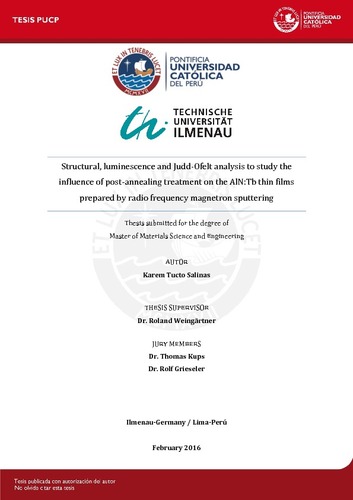| dc.contributor.advisor | Weingärtner, Roland | |
| dc.contributor.author | Tucto Salinas, Karem Yoli | es_ES |
| dc.date.accessioned | 2016-06-21T02:08:00Z | es_ES |
| dc.date.available | 2016-06-21T02:08:00Z | es_ES |
| dc.date.created | 2016 | es_ES |
| dc.date.issued | 2016-06-20 | es_ES |
| dc.identifier.uri | http://hdl.handle.net/20.500.12404/6998 | |
| dc.description.abstract | This thesis investigates the effects of the annealing treatments on the spontaneous emission,
radiative lifetime, composition and structure of terbium doped aluminum nitride films
deposited on silicon substrates by radio frequency magnetron sputtering. The purpose of this
thesis is to determine the Judd-Ofelt intensity parameters from the emission spectrum, in
order to calculate the radiative lifetime, branching ratios and spontaneous emission
probability. The optimal annealing temperature for the emission of terbium doped aluminum
nitride is investigated. The annealing treatment was performed in the temperature range
starting from 500 up to 1000°C. Two annealing techniques were investigated: rapid thermal
processing and a rather slower quartz tube furnace. Furthermore, two heating approaches
were applied: direct heating at 500, 750, 900 and 1000 °C, and multistep heating of 500-750°C,
750-900°C and 900-1000°C. The film was then characterized to determine which conditions
resulted in the highest emission of Tb. The film characterization includes the use of X-ray
diffraction to study the film’s crystal orientation, Energy dispersive X-ray spectroscopy to
determine the film composition, Scanning electron microscopy and Reflection high-energy
electron diffraction to resolve the surface morphology and structure of the film respectively.
The luminescent intensity and the radiative lifetime were analyzed using cathodoluminescence
measurement and Judd-Ofelt analysis. This work shows that the activation of the Tb ions to
enhance the emitted cathodoluminescence intensity depends on the structure of the film and
the oxygen concentration. The best annealing temperature to produce the highest emitted
light intensity in this set of experiments were the single-step heating at 750°C using rapid
thermal processing. | es_ES |
| dc.description.abstract | En la presente tesis se investiga la influencia del tratamiento térmico en la probabilidad de
emisión espontánea, el tiempo de vida radiativa, la composición y la estructura de películas
delgadas de nitruro de aluminio dopadas con terbio depositadas sobre substratos de silicio por
la técnica de pulverización catódica de radiofrecuencia.
La tesis tiene por objetivo aplicar el análisis de Judd-Ofelt usando el espectro de emisión. Se
propone un método que utiliza la intensidad de las bandas de transición del espectro de
emisión y las ecuaciones de Judd-Ofelt para calcular las propiedades espectrales: tiempo de
vida radiativa, tasa de los canales de transición y probabilidad de emisión espontánea. Usando
el software Wolfram Mathematica 9.0 se implementa un programa con el método propuesto.
Las películas se trataron térmicamente a 500, 750, 900 y 1000 °C. Se investigaron dos técnicas
del tratamiento térmico: Tratamiento térmico rápido y Horno tubular de vidrio de cuarzo. Con
el tratamiento térmico rápido se usaron dos tipos de calentamiento: calentamiento directo a la
temperatura de tratamiento térmico, y calentamiento sucesivo de la película desde la menor
hasta la mayor temperatura.
El análisis estructural de las películas fue realizada con difracción de rayos X. A nivel de
superficie se caracterizó la estructura y la morfología con las técnicas de difracción de
electrones reflejados de alta energía y microscopía electrónica de barrido. La luminiscencia fue
medida con la técnica de catodoluminiscencia. Las propiedades espectrales fueron calculadas
usando el método propuesto.
La intensidad de luz emitida se incrementó y luego decayó con la temperatura de tratamiento.
La relación entre la intensidad de emisión, la estructura, composición y los parámetros de
Judd-Ofelt son mostrados mediante gráficas y tablas. Los resultados obtenidos muestran una
mayor activación de los iones de terbio en las películas calentadas directamente a 750°C
usando el tratamiento térmico rápido. | es_ES |
| dc.description.uri | Tesis | es_ES |
| dc.language.iso | spa | es_ES |
| dc.publisher | Pontificia Universidad Católica del Perú | es_ES |
| dc.rights | Atribución-NoComercial-SinDerivadas 2.5 Perú | * |
| dc.rights | info:eu-repo/semantics/openAccess | es_ES |
| dc.rights.uri | http://creativecommons.org/licenses/by-nc-nd/2.5/pe/ | * |
| dc.subject | Luminiscencia | es_ES |
| dc.subject | Películas delgadas--Análisis estructural | es_ES |
| dc.subject | Espectrometría | es_ES |
| dc.subject | Microscopia electrónica | es_ES |
| dc.title | Structural, luminescence and Judd-Ofelt analysis to study the influence of post-annealing treatment on the AIN:Tb thin films prepared by radiofrequency magnetron sputtering | es_ES |
| dc.type | info:eu-repo/semantics/masterThesis | es_ES |
| thesis.degree.name | Magíster en Ingeniería y Ciencia de los Materiales | es_ES |
| thesis.degree.level | Maestría | es_ES |
| thesis.degree.grantor | Pontificia Universidad Católica del Perú. Escuela de Posgrado | es_ES |
| thesis.degree.discipline | Ingeniería y Ciencia de los Materiales | es_ES |
| renati.discipline | 713017 | es_ES |
| renati.level | https://purl.org/pe-repo/renati/level#maestro | es_ES |
| renati.type | http://purl.org/pe-repo/renati/type#tesis | es_ES |
| dc.publisher.country | PE | es_ES |
| dc.subject.ocde | https://purl.org/pe-repo/ocde/ford#2.05.01 | es_ES |






